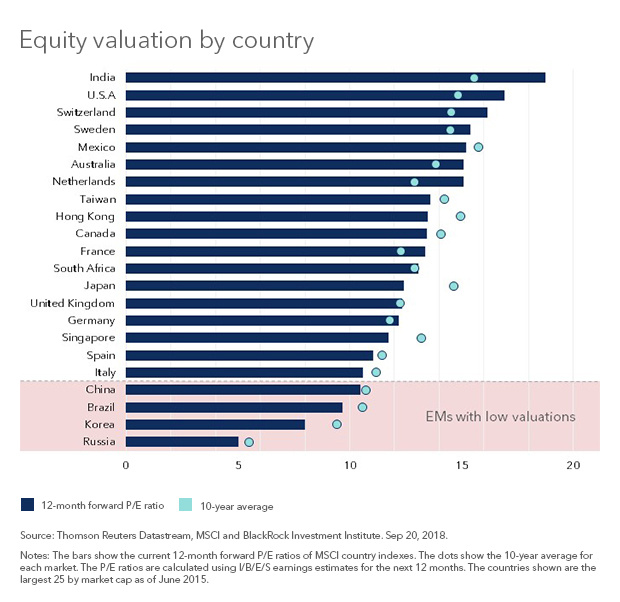by Russ Koesterich, Portfolio Manager, Blackrock
Investors may be ready to abandon emerging markets, but as Russ discusses, the potential is there for a sizeable rebound.
U.S. technology is once again ascendant. Since the fall of 2016, the S&P 500 Technology Sector Index is up nearly 70%; the tech sector now accounts for more than 25% of the S&P 500 market capitalization.
Despite the strength of the recent rally, tech enthusiasts will recall a long, long period of unpopularity. After peaking in early 2000, the tech sector lost more than 80% of its value. It then took 17 years until the sector reclaimed its 2000 peak.
Investors in emerging market (EM) stocks should keep that history in mind as they go through a similar, albeit less prolonged drought. The MSCI Emerging Markets Index is trading at approximately the same level as it did in early 2010.
Value, or the lack thereof, played a part
Valuations in emerging markets never approached the Olympian heights that tech stocks traded at in the late 1990s. That said, valuations have played a part in emerging markets’ struggles.
Since coming out of their own financial crisis in late 1990s, emerging market stocks have tended to trade in a well-defined range versus developed markets: a 45% discount to a 10% premium (based on price-to-book). Periods when EM stocks traded at a premium, such as late 2007 and 2010, turned out to be market tops. Interestingly, EM’s recent 20% drop was not proceeded by egregious valuations. In January, EM stocks were trading at approximately 1.9 times x book, a 23% discount to the MSCI World Index.
Another bottom?
Following the recent correction, EM stocks are trading at levels that preceded previous rebounds. EM equities are trading at roughly 1.55 times price-to-book (P/B), the lowest since late 2016 and a 35% discount to developed markets. Price-to-earnings (P/E) measures paint a similar picture. Current valuations represent a 33% discount to developed markets. Today, countries from Russia to South Korea are trading at less than 10x earnings (see Chart 1).
Of course, valuations are never the complete story. In the short term, they might not even be that relevant. As I discussed back in August, an EM rebound probably requires two other components: a flat-to-cheaper dollar and signs of an economic rebound. On the former, emerging markets should be getting some relief as the dollar is now down nearly 3% from its August peak.
In terms of economic growth, the picture is more mixed. In late July it briefly looked like emerging market economies were growing faster than expectations. That rebound proved fleeting. Going forward, investors should focus on China, where efforts to accelerate the economy through monetary stimulus are accelerating. Typically, these efforts start to impact the real economy with a 1-2 quarter lag.
Continuing pressure on particular EM countries–notably Turkey and Argentina–are partially responsible for recent losses. Escalating trade frictions have not helped. Still, should the dollar remain stable and China begin to accelerate, valuations suggest the potential for a sizeable rebound.
Bottom Line
For investors who have given up on emerging markets, it may be worth recalling that nine years after peaking, U.S. technology stocks were still down nearly 80%. From there the sector began a rally that has lasted more than nine years and resulted in a gain of more than 500%.
Russ Koesterich, CFA, is Portfolio Manager for BlackRock’s Global Allocation team and is a regular contributor to The Blog.
Copyright © Blackrock

















